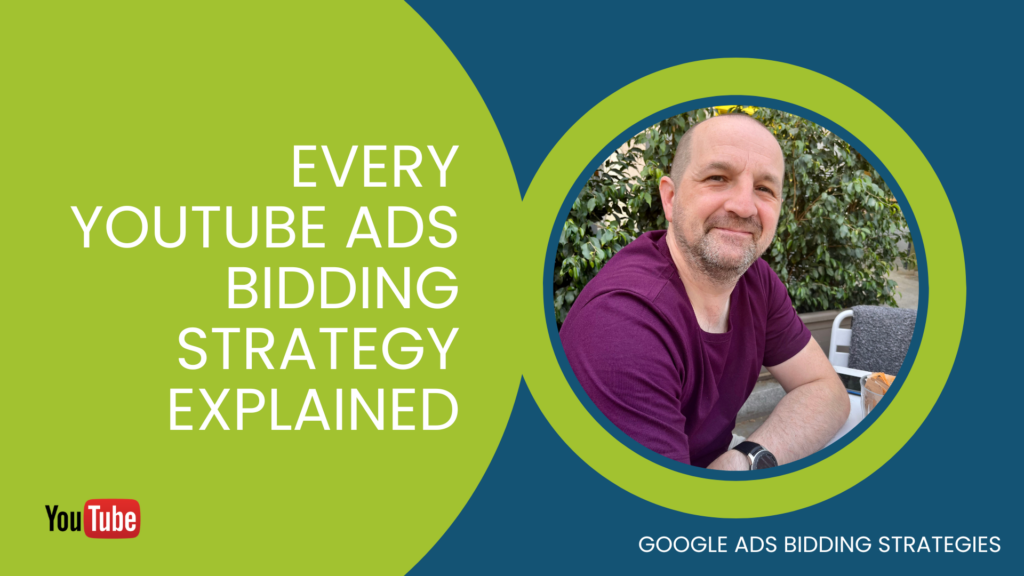YouTube Ads provide a powerful platform to reach a wide range of audiences through video content. However, creating compelling ads is only half the battle. Without an effective bidding strategy, your ads may not reach your intended audience or generate the desired results.
With several bidding strategies available for YouTube Ads, it can be overwhelming to determine which is best for your business goals. In this post, we will explore each bidding strategy available for YouTube Ads and provide a brief overview of its benefits and limitations, helping you make an informed decision for your advertising campaigns.
This post is part of the Google Bidding Strategies Guide — created by our Google Ads Agency Team
In this series:
- Manual CPC Bidding in Google Ads: A Comprehensive Guide
- Enhanced CPC (eCPC) Bidding In Google Ads Explained
- How to Optimise Google Ads Using Target CPA Bidding
- How to Optimise Google Ads Using Target ROAS Bidding
- Google Ads Maximise Conversions Bidding Strategy Explained
- Google Ads Maximise Clicks Bidding Strategy Explained
- Google Ads Target Impression Share Bidding Strategy
- How and When to Use the Maximise Conversion Value Bidding Strategy in Google Ads
- Choosing the Best Bidding Strategy for Google Display Ads
- Every YouTube Ads Bidding Strategy Explained
- Bidding Strategies to Maximise Google Shopping Performance
- Manual Bidding vs Automatic Bidding: Which is Better?
YouTube Ads Bidding Strategies
- Cost-per-View (CPV) Bidding: This bidding strategy charges advertisers each time a viewer watches a video ad for at least 30 seconds or interacts with the ad in some other way.
- Enhanced Cost-per-Click (eCPC) Bidding: This bidding strategy automatically adjusts bids based on the likelihood of a conversion to help improve campaign performance.
- Maximise Clicks Bidding: This bidding strategy optimises towards generating the maximum number of clicks within the given budget.
- Maximise Conversions Bidding: This bidding strategy uses machine learning to optimise towards maximising the number of conversions at the lowest possible cost.
- Target Cost-per-Acquisition (tCPA) Bidding: This bidding strategy sets a target cost-per-acquisition, allowing advertisers to optimise their campaigns towards their desired conversion goals.
- Maximise Conversion Value Bidding: This bidding strategy is similar to maximise Conversions, but instead of optimising for the most conversions at the lowest possible cost, it focuses on maximising the conversion value.
- Target Return on Ad Spend (tROAS) Bidding: This bidding strategy sets a target return on ad spend, allowing advertisers to maximise the revenue generated from their ad spend.
Each of these bidding strategies has its own strengths and weaknesses, and choosing the right one will depend on the advertiser’s goals, budget, and target audience. It’s important to experiment with different strategies to find the one that works best for your specific needs.
Cost-per-View (CPV) Bidding in YouTube Ads
Cost-per-View (CPV) bidding is a popular bidding strategy for YouTube Ads. With CPV bidding, advertisers only pay when someone watches their video ad for at least 30 seconds or interacts with their ad. This bidding strategy can help businesses maximise their video views and engagement, while keeping costs under control.
Pros of CPV Bidding:
- Cost-effective: CPV bidding allows advertisers to only pay for views of their video ads, rather than paying for impressions or clicks.
- Engagement-based: As advertisers are only charged when viewers engage with their ads, it incentivises the creation of engaging content.
- Easy to set up: Setting up CPV bidding is a simple process and can be done through the Google Ads platform.
Cons of CPV Bidding:
- Viewers may skip the ad: As CPV bidding only charges advertisers when viewers watch their entire ad, they may choose to skip the ad after a few seconds. This means that advertisers may not get as many views as they would like.
- Limited targeting options: CPV bidding only allows for targeting by demographics, interests, and topics. This may not be enough for advertisers looking for more specific targeting options.
Optimisation Opportunities:
- Targeting: Advertisers can optimise their CPV bidding strategy by using the right targeting options to reach their desired audience.
- Ad creative: Creating engaging video ads that capture the attention of viewers and incentivise them to watch the entire ad can improve the success of CPV bidding.
- Ad placement: Advertisers can optimise their ad placement by targeting specific placements on YouTube or using contextual targeting to reach viewers with related interests.
Learn more: How to Connect with Your Target Audience
Enhanced Cost-per-Click (eCPC) Bidding in YouTube Ads
Enhanced Cost-per-Click (eCPC) bidding is a bidding strategy that allows advertisers to adjust their bids in real-time based on the likelihood of a conversion. This strategy is available for YouTube Ads and it works by analysing the user’s browsing history, search queries, and other relevant factors to determine the likelihood of a conversion. eCPC bidding can help improve campaign performance while still allowing businesses to maintain some control over their bids.
One of the main benefits of eCPC bidding is that it can help advertisers reach their target audience more effectively. By analysing user behaviour, eCPC bidding can determine which users are more likely to convert and adjust bids accordingly. This can help advertisers get the most out of their advertising budget by focusing on users who are more likely to take action.
However, one potential drawback of eCPC bidding is that it can be difficult to predict how the algorithm will adjust bids. While it can be a powerful tool for optimising ad campaigns, it may not always be predictable or consistent in its performance.
To optimise eCPC bidding, it’s important to ensure that conversion tracking is configured correctly and that there is enough conversion data to support machine learning. Advertisers should also regularly review their bidding strategies and adjust their bids as needed to ensure that they are getting the best possible results.
Learn more:
- Enhanced CPC (eCPC) Bidding In Google Ads Explained
- Conversion Rate Optimisation Services | CRO Agency
Popular Google Ads Videos
Maximise Clicks Bidding in YouTube Ads
maximise Clicks Bidding is a strategy in YouTube Ads that focuses on driving the maximum amount of clicks for your budget. With this strategy, Google Ads automatically adjusts bids in real-time to help you get as many clicks as possible within your budget.
Pros of Maximise Clicks:
- This strategy is ideal for businesses that want to increase their website traffic and generate leads.
- It’s an easy and convenient way to manage your bids, as Google Ads does most of the work for you.
- You can set a daily budget, which ensures that you don’t overspend on your campaigns.
Cons of Maximise Clicks:
- This strategy is focused on clicks, not conversions, so you may not see a direct impact on your sales or revenue.
- It can lead to a higher bounce rate on your website if the clicks you generate are not targeted to the right audience or landing page.
Optimisation Opportunities:
- Ensure that your targeting options are set up correctly to reach the right audience.
- Use engaging ad creatives to entice viewers to click on your ads.
- Monitor your click-through rate (CTR) and adjust your bids and targeting as needed to improve performance.
Learn more: How to Connect with Your Target Audience
Maximise Conversions Bidding in YouTube Ads
Maximise Conversions bidding strategy in YouTube Ads is a smart bidding strategy that optimises for more conversions.
This bidding strategy is designed to maximise the number of conversions your ad campaign receives within your budget. It uses machine learning to automatically set bids in real-time, based on a user’s likelihood to convert.
Pros of Maximise Conversions:
- optimise for more conversions and maximise your budget.
- The bidding strategy automatically adjusts bids to improve performance.
- Machine learning algorithms are used to predict conversion likelihood.
Cons of Maximise Conversions:
- It may result in higher CPAs or lower conversion rates if not implemented correctly.
- You need to have enough conversion data to train the algorithm to predict conversions accurately.
- It may require a larger budget to see significant results.
Optimisation Opportunities:
- Focus on creating high-converting ad content that resonates with your target audience.
- Test different ad formats, such as TrueView for Action, to see which performs best for your campaign goals.
- Regularly analyse your campaign performance to identify areas for improvement, such as targeting or ad creative.
Learn more:
- Google Ads Maximise Conversions Bidding Strategy Explained
- Conversion Rate Optimisation Services | CRO Agency
- 5 Ways to Make Your Landing Pages Convert
Target Cost-per-Acquisition (tCPA) Bidding in YouTube Ads
Target Cost-per-Acquisition (tCPA) Bidding is a bidding strategy available for YouTube Ads that allows advertisers to set a specific cost per acquisition (CPA) goal for their campaigns.
This bidding strategy aims to generate as many conversions as possible at the target CPA set by the advertiser. Here are some pros and cons of using tCPA bidding in YouTube Ads:
Pros of tCPA Bidding:
- Helps to achieve the target CPA goal set by the advertiser
- Optimises ad delivery to users who are most likely to convert
- Saves time and effort by automatically adjusting bids for each auction
- Allows for better control over the campaign’s budget and ROI
Cons of tCPA Bidding:
- May require sufficient data for Google’s machine learning algorithm to optimise bids effectively
- May lead to higher CPAs if the target CPA is too low or unrealistic
- May not be suitable for campaigns with limited budget or conversions
Optimisation Opportunities:
- Adjust the target CPA based on campaign performance and conversion data
- Monitor and analyse campaign metrics such as conversion rate, cost per click (CPC), and ad placement to identify areas for improvement
- Test different ad formats, targeting options, and ad creatives to optimise campaign performance
- Continuously review and refine the bidding strategy based on campaign goals and performance.
Learn more:
Maximise Conversion Value Bidding. in YouTube Ads
Maximise Conversion Value Bidding is a bidding strategy in YouTube Ads that aims to optimise your ad placements to drive the most conversion value within your budget. It uses machine learning to automatically adjust bids based on the likelihood of conversion, and it takes into account factors such as user behaviour, device, location, and time of day.
Recent Google Ads Blog Posts
Pros of Maximise Conversion Value Bidding:
- Maximise Conversion Value Bidding can help you drive more value from your YouTube Ads campaigns by prioritising ad placements that are more likely to drive higher conversion values.
- It saves time by automating the bidding process and allows advertisers to focus on other areas of their campaign, such as ad creatives and targeting.
- It can help advertisers make more informed decisions about their advertising budget and optimise their return on investment (ROI).
Cons of Maximise Conversion Value Bidding:
- This bidding strategy requires a large amount of conversion data to work effectively, which can be a challenge for new advertisers or those with low traffic.
- It may result in higher cost-per-click (CPC) and cost-per-action (CPA) than other bidding strategies.
Optimisation Opportunities:
- Make sure your conversion tracking is set up correctly to ensure that your bids are being optimised for the right metrics.
- Use a targeted audience to drive high-value conversions and improve the performance of your campaigns.
- Regularly review and adjust your bidding strategy based on the performance data to ensure that you are getting the most value from your advertising budget.
Learn more:
- How and When to Use the Maximise Conversion Value Bidding Strategy in Google Ads
- The Ultimate Guide to eCommerce CRO
- eCommerce CRO Agency | Boost Conversion Rates and Revenue
Target Return on Ad Spend (tROAS) Bidding in YouTube Ads
Target Return on Ad Spend (tROAS) bidding is a bidding strategy in YouTube Ads that allows businesses to set a target return on their advertising spend.
This strategy takes into account the revenue generated from each click on an ad and adjusts the bid to maximise the return on investment.
Pros of tROAS Bidding:
- Helps to maximise the ROI by adjusting bids based on the expected revenue from each click
- Allows businesses to set a specific target for their advertising spend and ROI
- Can be particularly useful for businesses with high-value products or services
Cons of tROAS Bidding:
- Requires accurate revenue tracking to be effective
- May require a significant amount of historical data to properly train the algorithm
- May result in a lower volume of clicks and conversions compared to other bidding strategies
Optimisation Opportunities:
- Regularly review and adjust the target ROAS to ensure it is aligned with business goals and performance
- Continuously track and optimise revenue tracking to ensure accurate data for the algorithm
- Adjust targeting and creative strategies to optimise for higher-value customers and products/services
Learn more:










